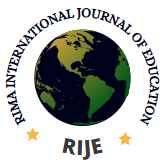Unlocking the Potential of E-Learning in Zamfara State: A Study on Awareness, Access, and Utilization Among Upper Basic and Senior School Teachers
*1Muhinat Bolanle Bello and 2Idris-Iyekolo Olushola
*1&2Department of Social Sciences Education, Faculty of Education, University of Ilorin, Kwara State, Nigeria Email: 1bello.mb@unilorin.edu.ng ORCID: https://orcid.org/ 0000-0001-5181-79081 Email: iyekolo.oa.@unilorin.edu.ng2
Abstract
The study conducted in Zamfara State, Nigeria, assesses the awareness, accessibility, and utilization of e-learning facilities among upper-basic and senior school-teachers. A descriptive research design was adopted for the study. A sample size of 356 teachers from 15 public schools in Bukkuyum, Bungudu, and Zurmi LGAs participated in the research. The instrument used for data collection was a researchers’-designed questionnaire focusing on "Awareness, Availability, Accessibility, Usability, and Challenges of E-learning Facilities for Teaching." This questionnaire demonstrated psychometric properties of content validity and a reliability index of 0.84. Data was collected through self-administration with the assistance of five research assistants. Results and Discussion: The findings revealed that a significant percentage of teachers were unaware of available e-learning facilities, facing challenges related to internet connectivity, technical support, electricity supply, affordability of tools, and digital literacy. Conclusion: This study underscores the need for increased awareness, training, and infrastructure improvement to enhance the effective integration of e-learning in educational practices in Zamfara State.
Keywords
E-learning, Availability, Awareness, Challenges, Accessibility and Utilizability
Reference
Algahtani AF (2011). Evaluating the effectiveness of the e-learning experience in some universities in Saudi Arabia from male students’ perceptions. PhD thesis, Durham University, UK.
Ajayi, I.A. (2008). Towards effective use of information and communication technology for teaching in Nigerian colleges of education. Asian Journal of Information Technology, 7(5), 210 – 214.
Akanbi, B. E., & Akanbi, C. A. (2012). Bridging the digital divide and the impact on poverty in Nigeria. Advances in Multidisciplinary & Scientific Research Journal Publication, 3(4), 81–87
CIPESA. (2023). The state of e-learning in Africa: Challenges and opportunities. Collaboration on International ICT Policy for East and Southern Africa (CIPESA). Retrieved from www.cipesa.org
Erah, P. O. (2006). Introduction to E-learning Protocols. Paper Presented at ETF Capacity Building Workshop for Lecturers of Universities in Nigeria at the University of Uyo
Evarest, C.M. & Laura, A.P. (2011). Learning electronically in Nigerian Universities: The example of Federal University of Technology Minna, Nigeria, Journal of Emerging Trend in Computing and Information Sciences, 2(12), 696 – 700.
Gikandi, J., et al. (2011). Factors influencing the adoption of e-learning in educational institutions. Computers & Education, 57(2), 1214-1226.
Gold, S. (2001). E-learning: The next wave of experiential learning, developments in business. Simulation and Experiential Learning, 28 (1), 70 – 78.
Halim, A., Wahyuni, A., Malvina, & Yani, E. (2020). The impact of the use of the internet on the learning outcomes in physics for high school student. Journal of Physics: Conference Series, 1521,1-7.https://doi.org/10.1088/1742-6596/1521/2/022060
Jung, I., & Latchem, C. (2022). Quality Assurance and Accreditation in Distance Education and E- Learning: Models, Policies and Research. Retrieved from: https://www.researchgate.net/publication/270280455_Quality_Assurance_and_Accredi tati on _in_Distance_Education_and Learning_Models_Policies_and_Research
King, E. & Boyatt, R. (2015). Exploring factors that influence adoption of e‐learning within higher education. British Journal of Educational Technology 46(6).1272-1280.
Kopish, M., & Marques, W. (2020). Leveraging technology to promote global citizenship in teacher education in the United States and Brazil. Research in Social Sciences and Technology, 5(1), 45-69.
Langat, A.C. (2015). Barriers hindering implementation, innovation and adoption of ICT in primary schools in Kenya. International Journal of Innovative Research and Development. 4(2).
Mungai, L. N. (2010). Obstacles to the effective utilization of ICT in education: A review. International Journal of Education and Development using ICT, 6(1), 112-1
Nwagbo, C.R. & Ugwuanyi, C.S. (2011). Assessment of the level of lecturers’ information and communication technology (ICT) competence for the adoption of e-learning in Nigerian universities. International Journal of Educational Research, 11(1) 39 – 47.
Ngwu, K. (2014). ICT facilities availability in Nigerian schools: Implications for effective teaching. Journal of Educational Computing Research, 51(3), 345-358
Oluwalola, F. K., & Awodiji, O. A. (2019). Availability and utilization of e-learning facilities for management and business courses in universities in Kwara State, Nigeria. Nigerian Journal of Business Education, 6(2), 346-357
Okoro, F.N. (2008). Application of information and communication technology (ICT) in business education instructional methods in Nigerian universities. International Journal of Educational Research, 8 (1), 21- 27.
Ong, S.G.T. & Quek, G.C.L., (2023). Enhancing teacher–student interactions and student online engagement in an online learning environment. Learning Environments Research. 26, 681–707
Onyebuchi, V. C. (2015). Challenges in the application of e-learning in teaching and learning among secondary schools in Nkanu West L.G.A of Enugu State. Unpublished B.Sc Project report presented to the Department of Science and Computer Education, Enugu State University of Technology.
Okorieocha, K., & Eronini, U. (2016). Effective utilization of e-learning facilities in Nigerian secondary schools. Journal of Information Technology Education Research, 15(2), 178-192.
Ong, C., & Lai, J. (2019). Exploring the impact of e-learning on teaching practices. Journal of Educational Technology, 25(3), 88-101.
OECD. (2005). ICT in tertiary education: Defining a set of indicators. Retrieved from https://www.oecd.org/en/publications/2005/09/education-at-a-glance-2005_g1gh5bac.html
Owulu, O. (2016). Issues with availability and utilization of e-learning facilities in Nigerian secondary schools. International Journal of Educational Research & Technology, 7(1), 56-71.
Pirani, A. J. (2004). Supporting e-learning in higher education: Road map, tools for navigating complex decisions. EDUCAUSE Centre for Applied Research. Retrieved on 13th May, 2018 from www.educause.edu/edcar/
Ramma, Y., Rampersad, K., & Jugoo, S. (2018). Reimagining technology in education: Beyond knowledge construction to information access. Journal of Educational Technology and Innovation, 15(3), 45–58.
The Research Advisors (2006). Sample Size Table. Available at: https://www.research-advisors.com/tools/SampleSize.htm
University of Macau. (2018). Rain Classroom: China’s innovative online education platform. Retrieved from: Guide to Using Tsinghua Rain Classroom-Schwarzman Scholars at Tsinghua University
